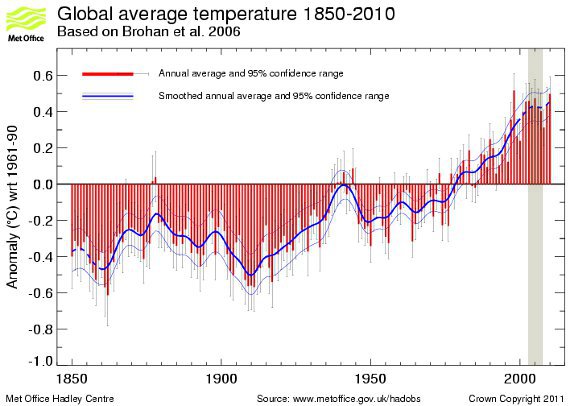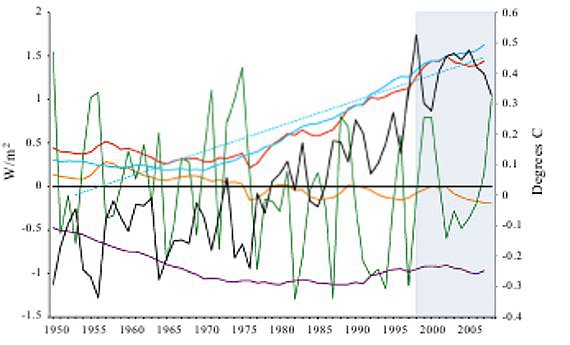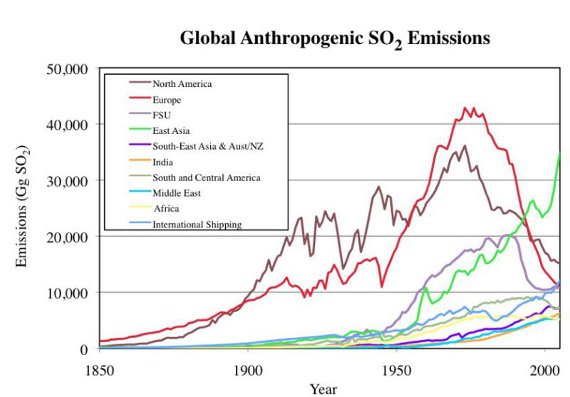Why Wasn't The Hottest Decade Hotter?
Posted on 15 July 2011 by Rob Painting
After a rapid rise in global surface air temperatures during the late 1970s to 1990s, the rate of global warming in the last decade or so has slowed. A recent scientific paper, Kaufmann (2011), suggests that once relevant factors are taken into consideration, the observed slow-down from 1998-2008 is in line with scientific understanding of the climate.
Rapid industrialization in East Asia, particularly China, led to a big jump in sunlight-reflecting sulfate aerosol pollution, mainly through coal burning. This additional reflective aerosol pollution sheilded the Earth from greater warming, but is only a temporary reprieve. Sulfates have a short lifetime in the atmsophere, and when East Asia stops burning so much coal, the Earth is going to get an extra nudge in warming.
20th to 21st Century global warming

Figure 1 - Hadley Centre temperature record (HADCRUT3).The red bars show the global annual average near-surface temperature anomalies from 1850 to 2009. The error bars show the 95% uncertainty range on the annual averages. The thick blue line shows the annual values smoothed. Vertical banded column indicates the 'slow-down' period.
The Hadley Centre dataset shows less global warming, compared to other records, primarily because it excludes measuring the Polar regions where warming is happening much faster than the global average. However the Hadley data still shows the decade 2000-2009 as the warmest on record. Looking at the above graph, it's clear that, despite the long-term warming trend, there are a number of short-term periods where global temperature shows little or no warming. So another slow-down in warming is hardly a novel observation.
Why the Pause?
To identify what may have led to this slow-down, Kaufmann (2011) use a statistical model to compare natural and human-caused forcings. They find that the increase in greenhouse gases was exceeded by an even greater increase in sunlight-reflecting sulfate aerosols, which originate from the rapid industrialization of China. Chinese coal-burning in particular doubled in the 4 years from 2003-2007, and makes up some 77% of the 26% global increase over that time.
The result of the modeling is that the cooling effect of sulfates nearly cancels out the warming effect of greenhouse gases, allowing natural processes to control the climate. In this interval, the small drop in sunlight reaching the Earth as part of the natural solar cycle, coupled with more episodes of La Niña (natural globally cool episodes) leads to a much smaller push in the direction of warming.

Figure 2 - Radiative forcing of human-caused sulfur emissions (purple line), net human-caused forcing (blue line), linear estimate of net human-caused forcing (blue dash), total radiative forcing (red line), radiative forcing of solar insolation (orange line), and observed temperature (black). The Southern Oscillation Index (divided by 10) is given in green. SOI data are presented as annual mean sea level pressure anomalies at Tahiti and Darwin. Post-1998 period of interest (highlighted gray). From Kaufmann (2011).
Kaufmann (2011) looks at other factors, such as Black Carbon (soot), and possible cooling caused by a reduction in water vapor in the stratosphere, however these are found to have a negligible effect on global temperature.
Another look at sulfate emissions
Smith (2011) look at human sulfate emissions from 1850-2005, based on estimates of production and consumption. They find a drop in the last part of the 20th century, but from 2000 to 2005 there is a big increase, largely from East Asia (China) and international shipping. So, this study is pretty much in agreement with the emissions data from Kaufman (2011).

Figure 3 - Global sulfur dioxide emissions by region (North America = USA+Canada; East Asia = Japan, China, and South Korea). From Smith (2011).
How do East Asian emissions become global?
Being based on a statistical model, rather than a climate model, Kaufmann 2011 can't tell us how a dramatic increase in East Asian sulfate pollution can have such a global effect; however, there has been earlier work addressing this question.
Rasch (2000) use the NCAR climate model to quantify the effect of reflective sulfate aerosols based on their location, or source. Those emissions which come from the Asian region are quite different from those that stem from pollution in North America and Western Europe. Unlike those regions, emissions from Asia are able to reach the upper atmosphere and spread out over both hemispheres, and thereby have a greater global impact.
Manktelow (2009) looked not only at the sulfate aerosols themselves, but also the impact they have on cloud formation. Their model reveals that both North America and East Asia have an impact 3 to 4 times greater than Europe because local weather patterns are able to loft sulfates up into the upper atmosphere, affecting cloud-forming processes. Once again demonstrating that not all sulfate emissions are created equal; Asia in particular packs a greater wallop.
First the good news.......then the bad
If the findings of Kaufmann (2011) are confirmed by other research, and it is accepted that East Asian sulfate pollution shielded the Earth from greater warming during 1998-2008, this is both good and bad news. It's good that the planet did not suffer greater warming, but bad because this effect is only temporary.
Sulfate aerosols have a short lifetime in the atmosphere, often measured in weeks and months, but up to 3 years if they reach the upper atmosphere. In contrast, greenhouse gases, especially CO2, will linger for centuries everywhere in the atmosphere. As East Asia begins to install smokestack scrubbers to reduce sulphate pollution, and they need to for reasons such as health and acid rain , then the cooling effect of those reflective aerosols will be lost. Once that happens we should observe a noticeable increase in global warming.































 Arguments
Arguments






























He says: "We used 25 years in Chapter 3 of IPCC as the lowest trend we provided that was meaningful…."
All the denier noise about "trends" with shorter time periods is much ado about nothing.
he calls it "the sum of the GHG and the aerosols, where the aerosols have been specified to be that which gives the agreement with the medium response function and what you see is that these two, the two principal forcings, greenhouse gases and aerosols cause this imbalance, [and] they cause the temperature change which is the major part of the observed temperature change, but they also cause this energy imbalance, which flattened out"
"because of that decrease in the greenhouse gas growth rate." By "decrease in the GHG growth rate", I'm thinking he means this chart from Perceptions of Climate Change:
which he used to show that the rate of increase in total GHG is actually less now than the peak rate of the mid 1980s. Back to Hansen: "But because it flattened out like that that allows small forcings to have a noticeable effect." So Kaufmann says Chinese aerosols masked the total global GHG forcing power for a while allowing smaller forcings to have a noticeable effect, and Hansen points to a lesser rate of increase in the total of GHG, if Hansen is talking about the same thing when he points to this flattening on this graph saying this allows the smaller forcings to have a noticeable effect. He finishes the talk with something I don't understand about Pinatubo: "And one of the interesting effects is the volcanoes. The Pinatubo aerosols gave us this big negative forcing and a cooling factor in 1991, and that only lasted for a couple of years. You wouldn't think it would be affecting things in the last ten years, but actually it does. Its because after the aerosols disappear, they're no longer influencing the amount of sunlight absorbed by the planet, but they're still influencing the heat radiation to space because they caused a cooling of the ocean, and therefore you continue to get this rebound effect after the volcanic aerosols are gone and that then causes a decline in the radiation imbalance in the last decade. And the other thing the solar irradiance…. ….So I think that the planetary imbalance is about 5 or 6 tenths of a watt. And if it's half a watt then in order to restore planetary balance and stabilize climate you'd have to reduce CO2 to 360 ppm other things being equal. And if its 3/4 of a watt, and I think averaged over a solar cycle it might be more like 3/4 of a watt, if that's the correct number then you'd have to reduce to 345 ppm. … In order to understand this we would like to have a model that really simulated this correctly. And I think that requires an ocean model that mixes ocean water and heat more realistically. That's what we're hoping this collaboration with …. Maybe we can get a more realistic ocean, if in fact I'm right that our ocean is mixing too much, but anyway, that's the story …." Kaufmann et.al. supporting appendix contained a reference to work at Princeton by Yuan Xu regarding the trend in Chinese SO2 emissions:
The Chinese SO2 may have peaked around 2006. Their total coal generation is slated to double by 2035 or so it seems, but they are replacing inefficient plants with more efficient ones even as they expand their overall fleet, while applying sulphur mitigation measures at fantastic rates to lower their emissions. Here's three equal sized areas, in the US midwest, Europe near Italy, and China around Beijing, data by Ozone Monitoring Instrument Group which is detecting SO2 concentration averaged 2005 - 2007 the peak of Chinese emissions, keep in mind that tiny dot in Sicily is the Mt Etna volcano, then look at China
[Source]